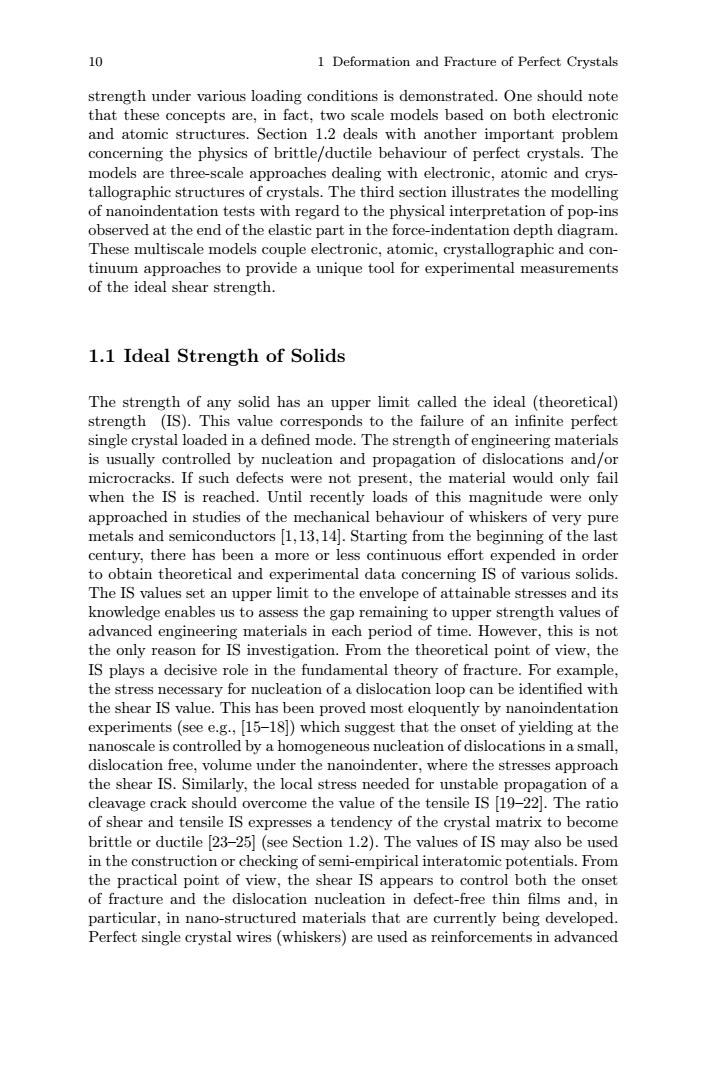正在加载图片...

10 1 Deformation and Fracture of Perfect Crystals strength under various loading conditions is demonstrated.One should note that these concepts are,in fact,two scale models based on both electronic and atomic structures.Section 1.2 deals with another important problem concerning the physics of brittle/ductile behaviour of perfect crystals.The models are three-scale approaches dealing with electronic,atomic and crys- tallographic structures of crystals.The third section illustrates the modelling of nanoindentation tests with regard to the physical interpretation of pop-ins observed at the end of the elastic part in the force-indentation depth diagram. These multiscale models couple electronic,atomic,crystallographic and con- tinuum approaches to provide a unique tool for experimental measurements of the ideal shear strength. 1.1 Ideal Strength of Solids The strength of any solid has an upper limit called the ideal (theoretical) strength (IS).This value corresponds to the failure of an infinite perfect single crystal loaded in a defined mode.The strength of engineering materials is usually controlled by nucleation and propagation of dislocations and/or microcracks.If such defects were not present,the material would only fail when the IS is reached.Until recently loads of this magnitude were only approached in studies of the mechanical behaviour of whiskers of very pure metals and semiconductors [1,13,14.Starting from the beginning of the last century,there has been a more or less continuous effort expended in order to obtain theoretical and experimental data concerning IS of various solids. The IS values set an upper limit to the envelope of attainable stresses and its knowledge enables us to assess the gap remaining to upper strength values of advanced engineering materials in each period of time.However,this is not the only reason for IS investigation.From the theoretical point of view,the IS plays a decisive role in the fundamental theory of fracture.For example, the stress necessary for nucleation of a dislocation loop can be identified with the shear IS value.This has been proved most eloquently by nanoindentation experiments(see e.g.,[15-18)which suggest that the onset of yielding at the nanoscale is controlled by a homogeneous nucleation of dislocations in a small, dislocation free,volume under the nanoindenter,where the stresses approach the shear IS.Similarly,the local stress needed for unstable propagation of a cleavage crack should overcome the value of the tensile IS [19-22].The ratio of shear and tensile IS expresses a tendency of the crystal matrix to become brittle or ductile 23-25(see Section 1.2).The values of IS may also be used in the construction or checking of semi-empirical interatomic potentials.From the practical point of view,the shear IS appears to control both the onset of fracture and the dislocation nucleation in defect-free thin films and,in particular,in nano-structured materials that are currently being developed. Perfect single crystal wires(whiskers)are used as reinforcements in advanced10 1 Deformation and Fracture of Perfect Crystals strength under various loading conditions is demonstrated. One should note that these concepts are, in fact, two scale models based on both electronic and atomic structures. Section 1.2 deals with another important problem concerning the physics of brittle/ductile behaviour of perfect crystals. The models are three-scale approaches dealing with electronic, atomic and crystallographic structures of crystals. The third section illustrates the modelling of nanoindentation tests with regard to the physical interpretation of pop-ins observed at the end of the elastic part in the force-indentation depth diagram. These multiscale models couple electronic, atomic, crystallographic and continuum approaches to provide a unique tool for experimental measurements of the ideal shear strength. 1.1 Ideal Strength of Solids The strength of any solid has an upper limit called the ideal (theoretical) strength (IS). This value corresponds to the failure of an infinite perfect single crystal loaded in a defined mode. The strength of engineering materials is usually controlled by nucleation and propagation of dislocations and/or microcracks. If such defects were not present, the material would only fail when the IS is reached. Until recently loads of this magnitude were only approached in studies of the mechanical behaviour of whiskers of very pure metals and semiconductors [1, 13, 14]. Starting from the beginning of the last century, there has been a more or less continuous effort expended in order to obtain theoretical and experimental data concerning IS of various solids. The IS values set an upper limit to the envelope of attainable stresses and its knowledge enables us to assess the gap remaining to upper strength values of advanced engineering materials in each period of time. However, this is not the only reason for IS investigation. From the theoretical point of view, the IS plays a decisive role in the fundamental theory of fracture. For example, the stress necessary for nucleation of a dislocation loop can be identified with the shear IS value. This has been proved most eloquently by nanoindentation experiments (see e.g., [15–18]) which suggest that the onset of yielding at the nanoscale is controlled by a homogeneous nucleation of dislocations in a small, dislocation free, volume under the nanoindenter, where the stresses approach the shear IS. Similarly, the local stress needed for unstable propagation of a cleavage crack should overcome the value of the tensile IS [19–22]. The ratio of shear and tensile IS expresses a tendency of the crystal matrix to become brittle or ductile [23–25] (see Section 1.2). The values of IS may also be used in the construction or checking of semi-empirical interatomic potentials. From the practical point of view, the shear IS appears to control both the onset of fracture and the dislocation nucleation in defect-free thin films and, in particular, in nano-structured materials that are currently being developed. Perfect single crystal wires (whiskers) are used as reinforcements in advanced